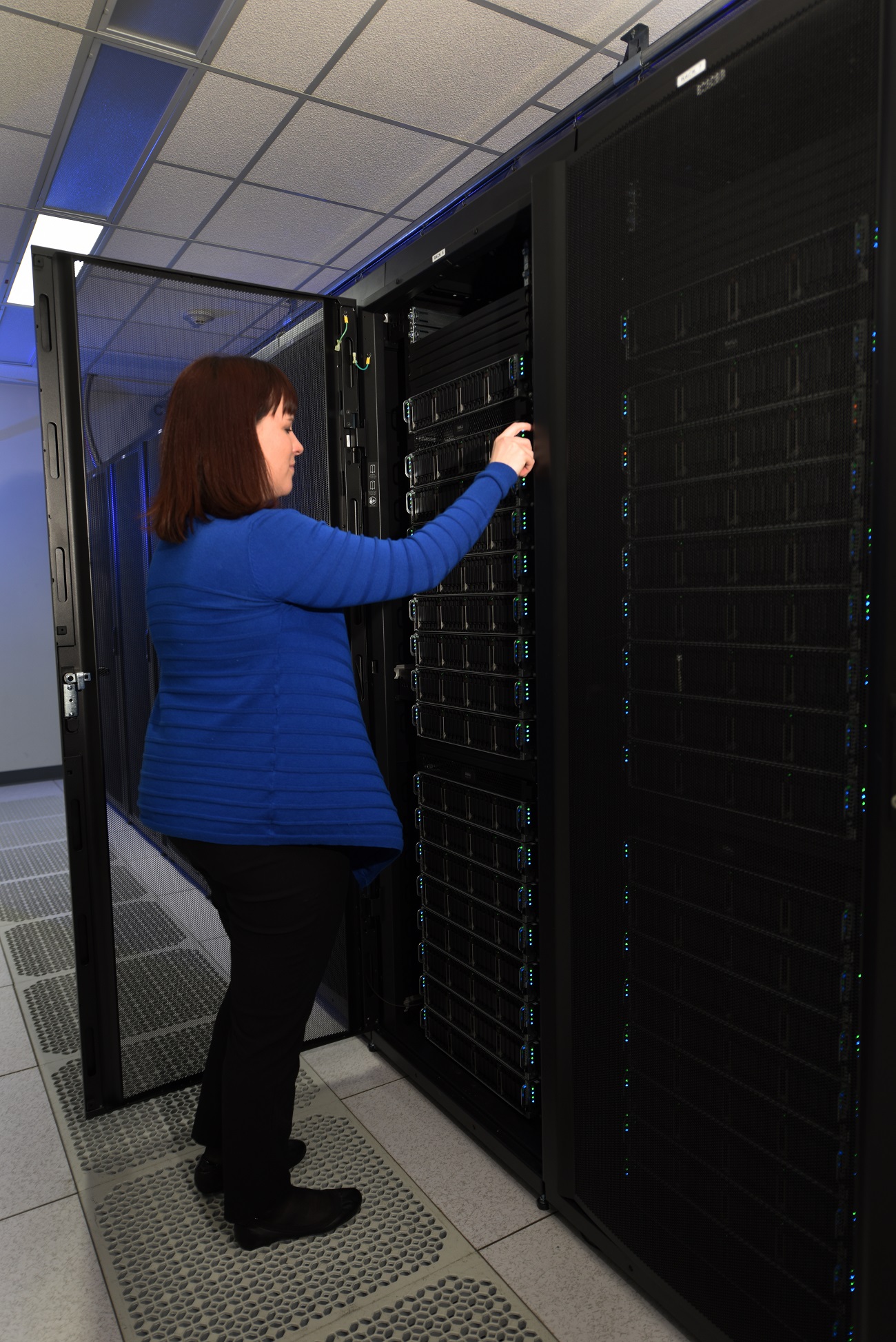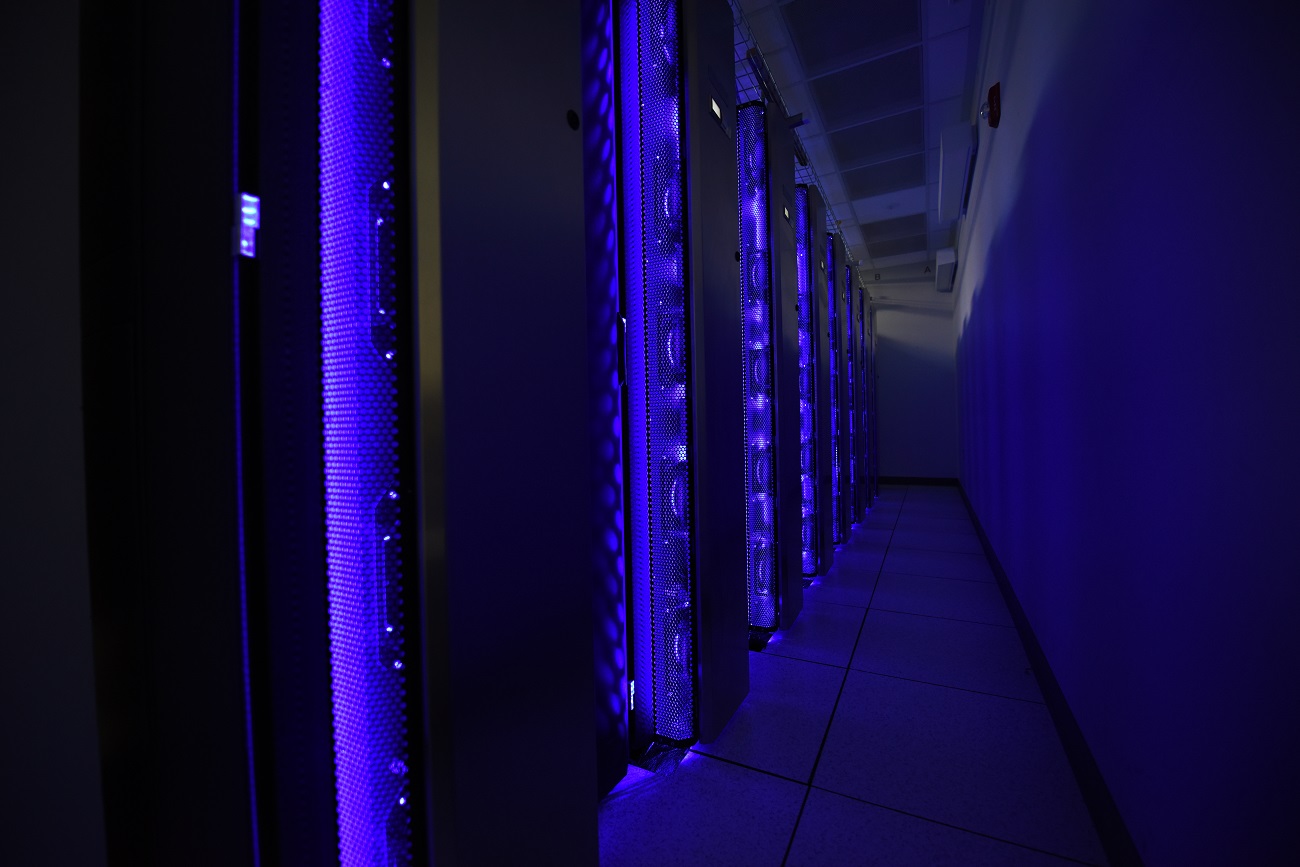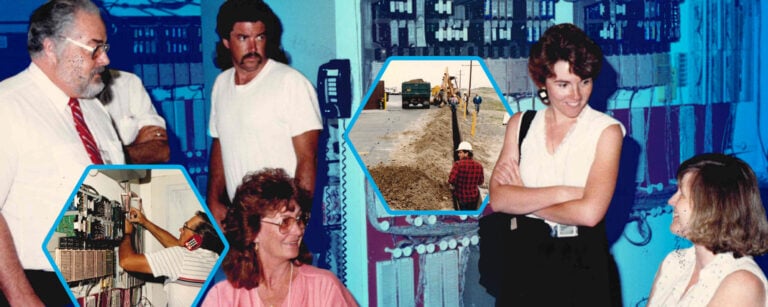Nuclear reactors embody complexity. Nuclear physics, materials science, fluid dynamics and mechanical engineering are just a few of the disciplines that combine to create nuclear energy. Today, thanks to ever more powerful supercomputers, scientists at Idaho National Laboratory are gaining a better understanding of the inner workings inside today’s and tomorrow’s nuclear reactors.
Derek Gaston, an INL computational scientist, recently simulated a quarter section of a nuclear reactor core to visualize the location of neutrons and ultimately, the areas of highest power.
The simulation will enable scientists to better understand fuel performance, which in turn makes it possible to extract more power from the reactor while still operating it safely.
Four months ago, this 3D, high-fidelity simulation would have been impossible to complete at INL. The lab simply didn’t have enough computing power. But with the recent addition of Lemhi, the lab’s newest supercomputer, Gaston was able to run the simulation in less than a day. With 20,160 cores and 94 terabytes of memory, Lemhi already is helping INL researchers conduct modeling and simulations that weren’t previously possible.
“Lemhi enabled this calculation,” Gaston said. “It really wouldn’t have been possible without it.”
INL’s supercomputing capabilities will become more robust when the lab adds Sawtooth, an even more powerful machine, to its new Collaborative Computing Center (C3) building, which is expected to open this fall. These machines are key to helping lower the costs and accelerate the development and deployment of new nuclear technologies.
Supercomputing can guide the design of physical experiments that are needed to test new hypotheses. By using simulations to predict how new fuels and designs will perform in the reactor environment, engineers can select only the most promising technologies for the real-world experiments that can take years to complete.
Steven Aumeier, an INL senior adviser and nuclear engineer, said advanced computing has always been integral to INL’s research and development and will play an even greater role with addition of the new systems.
“We simulate things, we build them and gather data, and then use the data to improve simulations so we can make the designs better, safer, more cost competitive,” Aumeier said. “As computers got more functional, faster and cheaper, we could do more and more in simulation environments, saving a huge amount of time and money and making our experiments better.”

Lemhi, installed earlier this year, joins Falcon, INL’s existing system. Lemhi gleans its name from the nearby Lemhi Pass region that straddles the Idaho-Montana border and contains the richest deposits of thorium in the nation, according to the U.S. Geological Survey. The slightly radioactive element is usable in nuclear energy research.
Lemhi has similar computing capacity to Falcon but serves a different function. Falcon is configured to run many, many, many jobs of various sizes simultaneously.
In short, Lemhi is set up as a capability machine, meaning Gaston can use its total capacity when running his modeling tool, known as MOCkingbird, which stands for Method of Characteristics. The tool runs in INL’s Multiphysics Object Oriented Simulation Environment (MOOSE), whose modeling applications are all named after Idaho fauna.
Had Gaston used the Falcon supercomputer for his simulation, he would have had to wait in line and it could have taken weeks to complete. Lemhi, however, completed the MOCkingbird quarter-core simulation in less than one day.
Like MOCkingbird, many of the MOOSE modeling applications will benefit from the increased supercomputing power. Lemhi also supports INL’s participation in the Consortium for Advanced Simulation of Light Water Reactors (CASL), a U.S. Department of Energy nuclear energy modeling and simulation hub.
One of Lemhi’s first official jobs was a weeklong training and workshop for people in the nuclear power industry to learn how to apply the software and simulate daily operations at a power plant. CASL hosted the training and workshop, allowing the 68 participants from 26 organizations to test Lemhi. Participants learned how to use the simulation software and appreciate the value of simulations.
“This had a huge impact on the industry,” said CASL’s Andrew Godfrey, the deputy focus area leader for advanced modeling applications. “We had about 40 people who don’t normally use software like this running on (Lemhi).”
Gaston’s project and the CASL workshop are just two of the efforts — and firsts — that Lemhi supports.
It also will help boost the computing power available to Idaho’s three public research universities — Boise State University, Idaho State University, and University of Idaho. The universities have long used a portion of INL’s supercomputing resources for their own research and now have access to more than 35,000 computer processor cores. Access to these capabilities can help the universities attract students and faculty whose research benefits from state-of-the-art supercomputing.
The addition of Lemhi, the C3 building — a collaboration with the state of Idaho — and Sawtooth will greatly increase the supercomputing power available to university educators and researchers.
“This allows INL to expand our computing capabilities and also open the door for universities to increase their scientific computing work,” said Eric Whiting, the INL manager of High Performance Computing and data analytics who has helped operate INL’s supercomputers.
Did you know?
INL’s two supercomputers, Falcon and the newly acquired Lemhi, both rank on the TOP500 as two of the 500 most powerful computer systems currently in operation. Falcon ranks No. 361 and Lemhi ranks No. 427.
With more than 100 new supercomputers coming online every six months, it is a prestigious honor to hold a position among the top supercomputers in the world.
Historically, INL has had six supercomputers recognized by the TOP500 list, which originated in the early 1990s. Falcon first made the list in November 2014.






